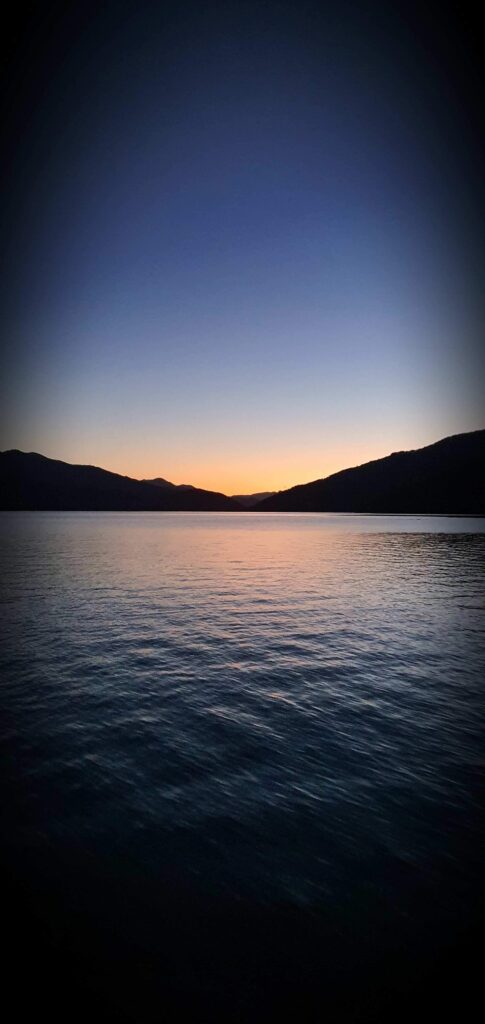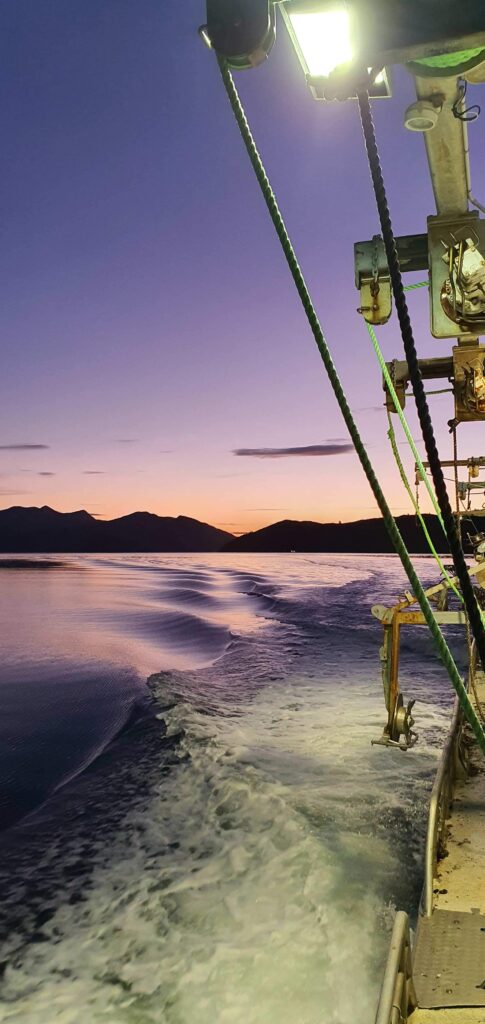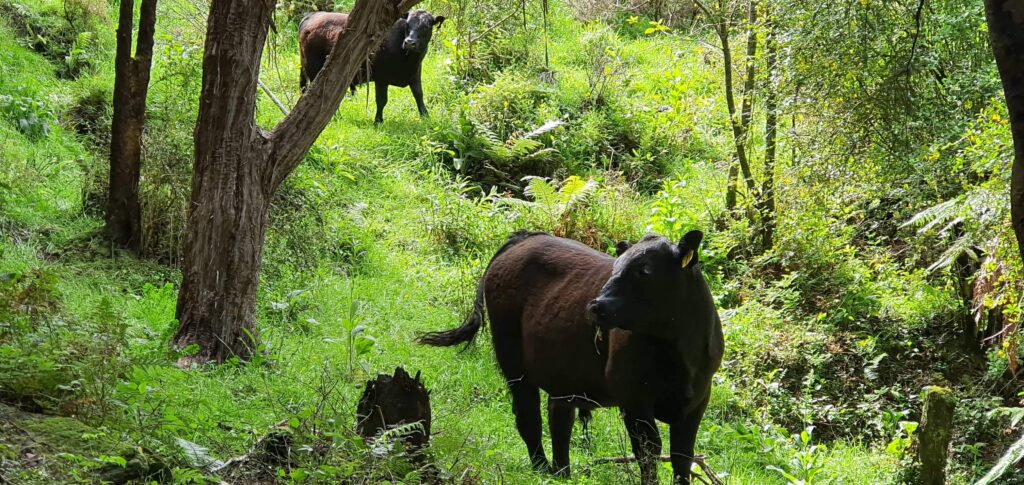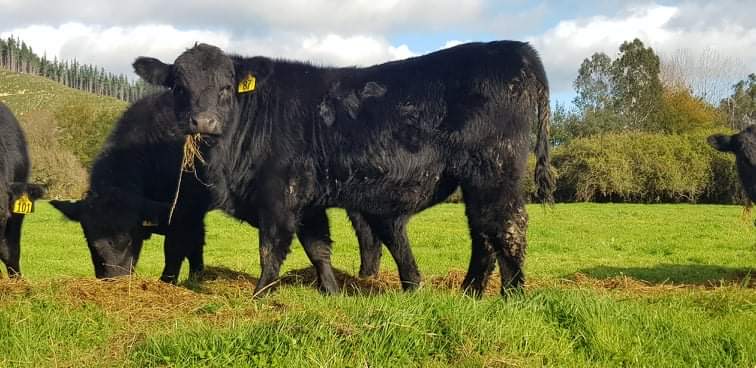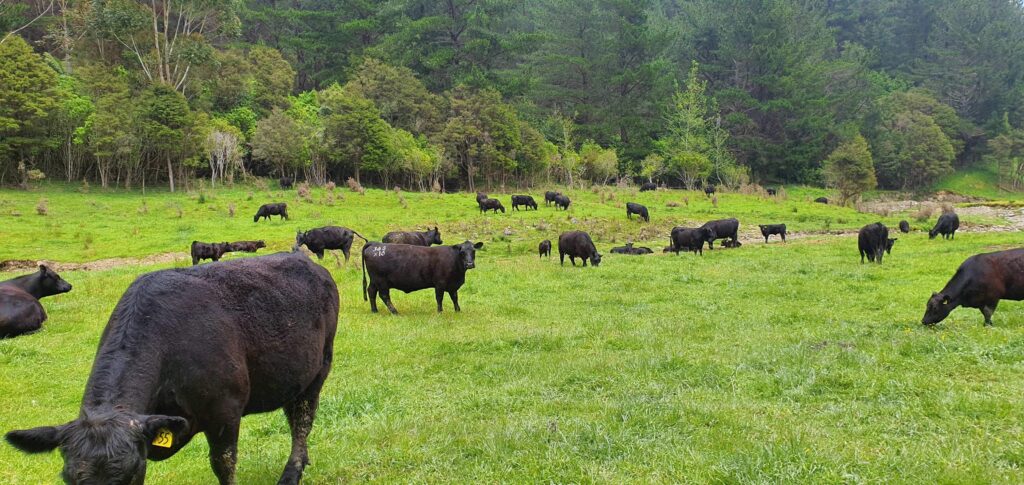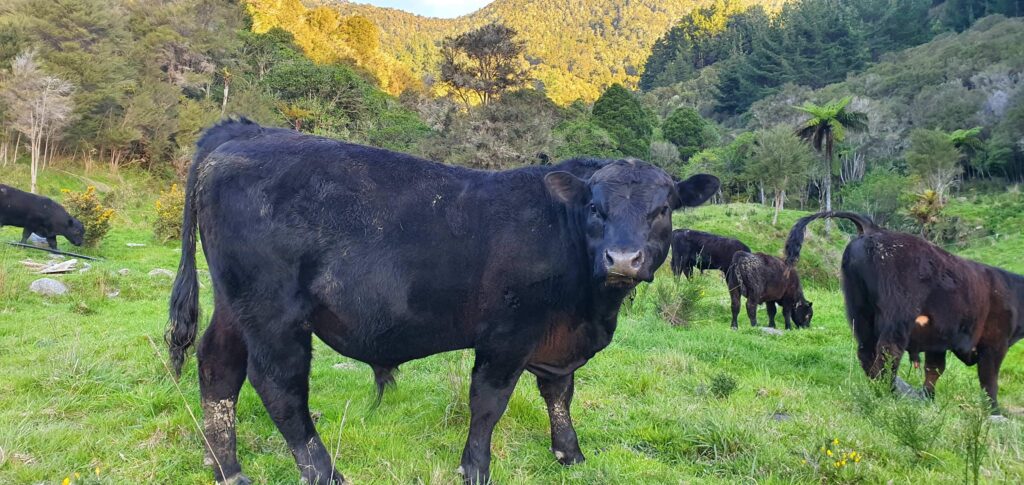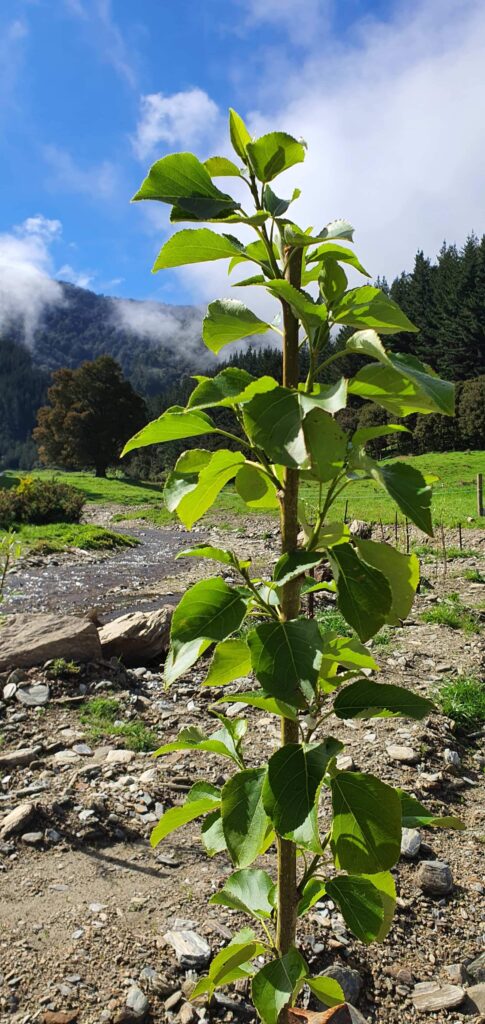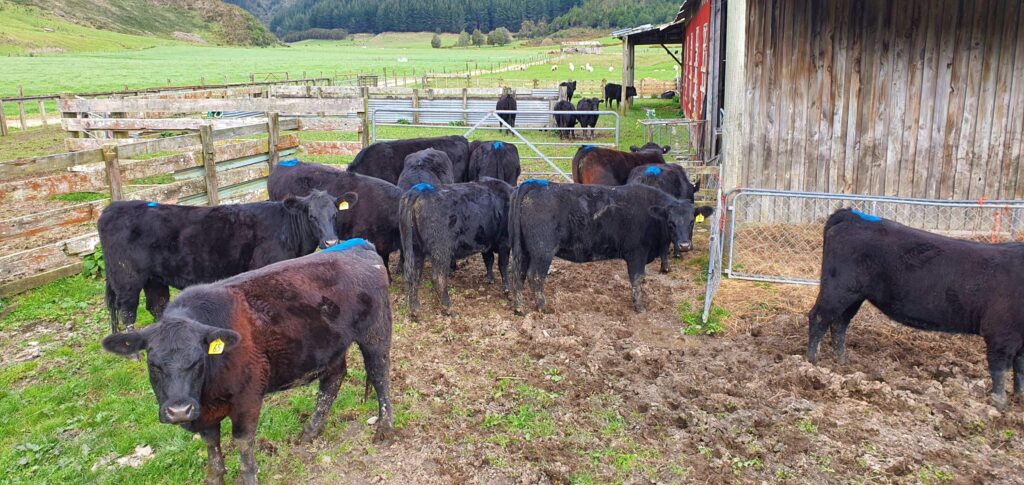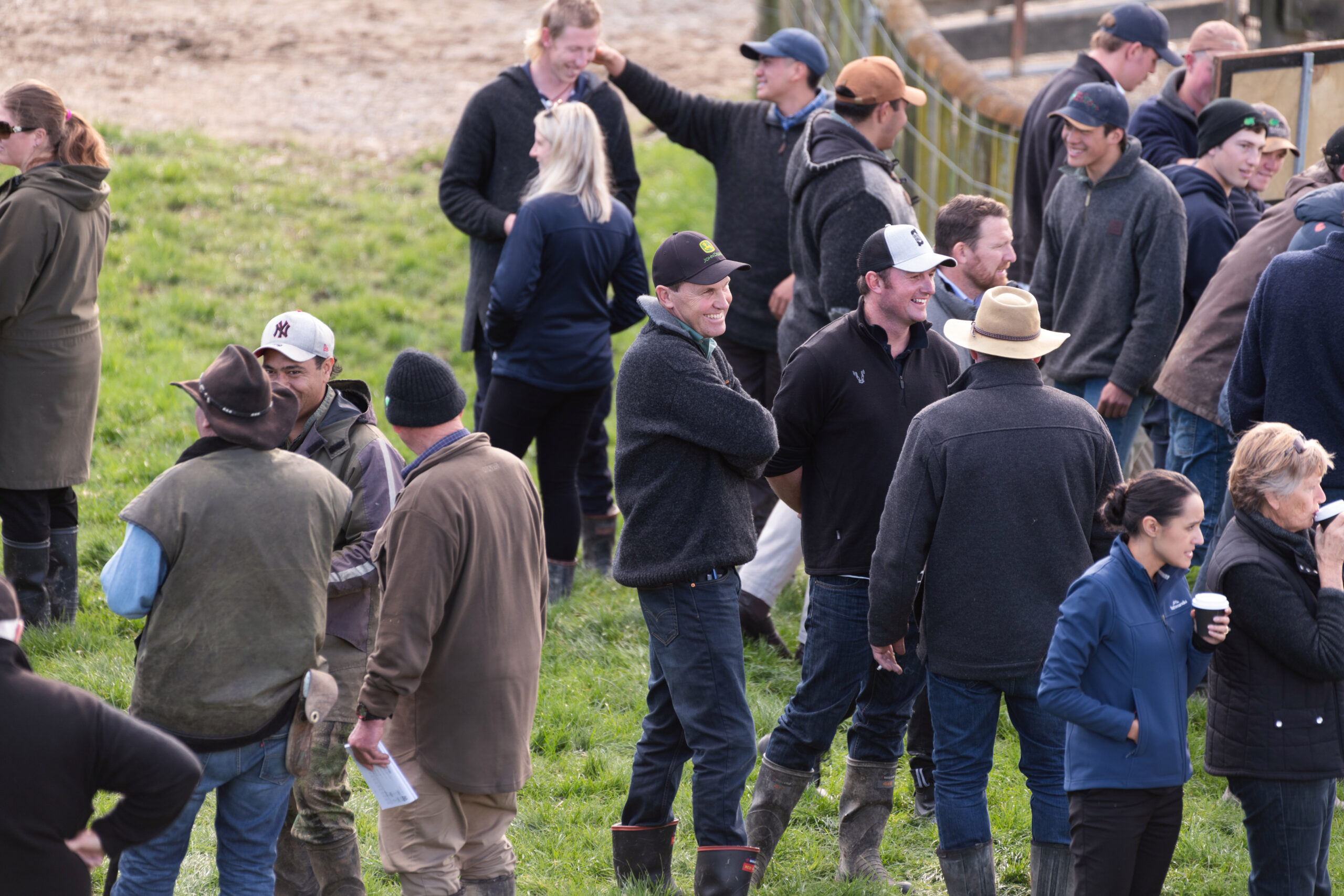
OKIWI
ANGUS
FOR BETTER BALANCED BEEF
Breeder Profile:
George MacPherson
Words by
Natalie Campbell
PASSION FOR CATTLE IN YOUNG MARLBOROUGH BREEDERS’ DNA

The cattle of the Okiwi Angus Stud are helping break in and develop farmland while enjoying million-dollar views of the picturesque Marlborough Sounds.
The stud belongs to new breeder George MacPherson and what he may lack in years he certainly makes up for in passion and drive.
George is a fourth-generation farmer and it’s abundantly clear from talking to him agriculture is in his DNA.
He says his father has always bred stud cattle, latterly pedigree Charolais and the family were some of the first settlers to the region helping to break in and settle the Anakiwa Valley at the head of the Queen Charlotte Sound.
“Stud cattle have been in the family for a long time, but I’m the first to breed Angus,” says George.
“I chose Angus because I’ve found them to be a more carefree easy-doing breed and that’s important to me because I’m here four days and then I’m at sea for four days.”
George spends half his time as second skipper for Sanford, skippering boats harvesting commercially farmed green lip mussel farms as well as undertaking scientific work for NIWA.
Partner Stacey and their two sons, Lucas who is just over a month old and Hunter, 5 years old look after the farm when George is away.
“Its important things are easy care when I’m away. Stacey comes from a farming background, she’s been dairy farming, and she’s a massive part of the business, but I like it to be easy for her.”
George, 27, says he had an interest in the Angus breed from a young age.
“When I grew up we reared Angus Friesian cross calves and I guess it’s grown from there.”
“I appreciate all beef cattle and all animals,” he says.
George, with Stacey’s support is now farming 258ha of which about a third is currently grazeable. The balance of the property includes 40ha pine trees and bush. The cattle primarily run on 65-75% of uncultivatable land, with the balance of the property cultivatable.
He says he has the task of taming the difficult terrain and breaking in the over-run country of the property and developing it into productive farmland.
“Angus are very good foragers and they’re doing a good job of helping break that country in.”
“A lot of it is wet muddy and steep country and it can be quite hard on the cattle particularly their feet, so we like sure-footed cattle and we keep an eye on their feet.”
The developed flat country is used to grow and sell standing feed and run dairy grazers – both options providing reliable income.
George’s property only carries Angus cattle (and a handful of sheep for the freezer) with 40 breeding cows and 15 heifer replacements. Next year he plans to calve 55 cows.
He currently has 30 registered mixed-age Angus cows and all the heifers are registered.
“From now on more will be registered as we build herd numbers.”
George says he decided to register his herd because he’s passionate about breeding good cattle and because he wanted his clients to be confident they were buying proven genetics.
“If I’m breeding something to go on to someone else, I want to know what I’m giving – the genetics – are the best I can offer, it’s all about integrity to me.”
Growth is a goal for the young family’s herd and George has his expansion plan mapped out.
His hope is that as he develops the home farm, he’ll be able to put the herd to work breaking in country for other land owners in the district.
“As the time nears, I’ll be looking for blocks to lease and develop.”
Breeding Philosophy:
George says because he’s at sea so often his breeding philosophy is largely focused on producing care-free cattle but he also believes in putting his customers first.
“We strive to provide an animal that we wouldn’t hesitate to use ourselves.”
“I’m looking for cows that will push into the scrub with their calves for shelter, good mums. Cows that can be left on a block for a while and I know they’re going to produce a good calf without me having to do too much and temperament is a very important trait.”
George says his oldest son Hunter, enjoys cattle so temperament is just as important personally as it is for his clients.
“Temperament is first and foremost, I don’t want my children to be scared of cattle. Hunter already loves cattle and helping me, he goes up to yearling bulls in the paddock and gives some of them a scratch.”
George also says a lot of his bull-buying clients are very loyal and repeat buyers, with many commenting on the quiet nature of the Okiwi bulls.
“They often talk about the temperament. Clients will come and walk in and around the bulls and I’m selling some to dairy farmers and they need good quiet bulls, they might have staff who aren’t comfortable with handling big bulls.”
Structural soundness and solid feet are also pivotal and George likes to deliver what his clients want – nice fleshy beefy looking animals.
His goal is to breed efficient and effective working cattle that will allow his business to keep up with global demands in areas of taste, look, time to slaughter and sustainability.
“While doing this, we also believe we have to produce good looking cattle. We don’t let the numbers get in the way of breeding what we believe are good looking animals. Angus are a beef breed, lets embrace the beefy type this breed can produce as well as using progressive data to match to keep the breed moving forward,” says George.
“I like good figures, but I also have to like the style and type of animal.”
He references Okiwi Dusty 66, a homebred sire George said is one of the highest indexing bulls in the South Pacific for Self-Replacing index, AngusPure and as well as the Heifer Dairy Terminal index.
Dusty is a sire that George is particularly proud of because he’s also been accredited as an AI Sire.
“Lindsay Jones came and inspected him and he’s been catalogued as an AI sire – Dusty was one of two bulls Lindsay chose. He also selected the bull Max Tweedie purchased from Mt Possession this year.”
He says he always encourages his clients to refer to EBVs and he has identified clients who are more interested and makes that paperwork available to them at bull selection time. He says birth weight and calving ease are often more of a focus for his diary farming clients.
“For me personally EBVs are a great tool but I don’t select cattle on numbers alone. The accuracy of EBVs is also important and to have good accuracy that animal needs to have plenty of progeny or relatives.”
Okiwi is an AngusPure partner and George says this has reinforced for him the role EBVs can play especially in regards to improving meat quality.
“As a breed it’s important we produce animals with good eating quality.”
The Okiwi herd is performance recorded and parent verified with George saying this is also an area he’d like to do more in and invest in recording gear.
How It All Began
The Okiwi Angus herd was established after his parents, Lynne and Ian MacPherson gave him two registered Angus bulls for his 21st birthday.
George said he already had his commercial Angus herd at that stage and while he was selling unregistered bulls he didn’t hesitate at the opportunity to use registered sires and become a registered breeder.
Quickly following the bulls George purchased three mixed age cows from Blacknight (Ben and Nadine Maisey) and more heifers, this time from Taimate (Paul Hickman) and 10 registered in calf heifers from Kakahu.
George credits his parents for their support and encouragement throughout his farming career to date.
“I wouldn’t have been able to do it without them and their support, they’ve been amazing,” he says.
With the stud registered six years ago, George has been selling bulls by private treaty, but earlier this year he was invited to offer sires at the Blenheim Combined Bull Sale.
“I was nervous about that. I offered three bulls and I offered them because they were bulls that I would have used in my own herd. They all sold above reserve.”
George says he wants to get the bulls out working and leaving their mark in commercial herds but ultimately one day in other stud herds.
“I hope to join the sale again and we’d like to get our genetics out there and one day make some transfers.”
“I’m here for the long haul and I will be making sure what I offer is good quality.”
When George isn’t working on the land he’s a second skipper for Sanford mainly in the Marlborough Sounds in aquaculture (mussel farming primarily). He says they also help carry out some scientific work for NIWA.
George says his knowledge of genetics and EBVs is transferable to mussel farming as Sanford are working to breed a genetically superior green shell mussel that’s quick growing with a thicker flesh.
“It’s similar to breeding cattle. We use the equivalent of EBVs to make that genetic progress,” he says.
George has all his skippers’ tickets and is currently going through his endorsement for 500 tonne vessels (30m+).
“I’ve been fishing and diving my entire life – I can see the Marlborough Sounds from my front yard.
Being a qualified skipper also means he has other strings to his bow, he’s proficient in welding and is mechanically minded.
“We have to have those traits and skills to skipper these boats – it means I can make my own farm implements if need be.”
The property is situated at Anakiwa, also known as being home to Outward Bound and George admits the cattle enjoy some spectacular views.
“The cattle have million-dollar views – the bulls get to overlook D’Urville Island.”
Property Development
And while they farm in a picturesque location, George says this winter there was significant flooding that removed new fences and caused damage.
Annual rainfall in the area sits at about 1600-1800mm annually and the property sits at the bottom of four large gully’s so they bore the brunt of the weather event as it left the hills.
Not only did the flooding take out fences, but he lost land from slips and creek corners being scoured out, in some cases 15m from their original position.
He says their soil type, which is generally a thin layer of top soil on fine stones, means once the water gets in it easily causes damage.
“There’s no stopping it once it gets in.”
One of the challenges, unique to the MacPherson property is, that it can look nice and green and lush, but the soil type and high rainfall means it can be hard on the feet of stock than a drier farm.
“Their feet are wet a lot and can easily bruise. Hooves don’t get that constant filing they would on a drier property, so good feet are very important to us. We are particularly hard on feet because we can’t afford anything to go wrong.”
George says the Marlborough area is unique in the fact it’s rainfall can change massively in a short distance.
“We are fairly wet but the Wairau plains are dry yet they’re only a short distance away.”
“I’ve always been told it’s the hot days drawing the moisture off the sea, causing it to rain in the hills.”
Farming on the shores of the Marlborough Sounds, George is very aware of the impacts farming practices can potentially have and this is why he’s chosen the policies and practices he’s implementing in his business.
“A lot of our waterways are fenced off and planted – I’m proactive about water quality. I’ve invested thousands of dollars into fencing and riparian planting, so a lot of it is double fenced – I’ve bought my own post driver to do all the fencing.”
“I want to protect the waterways. I did 1.5km 18 months ago but it all got washed away in the floods earlier this year so I’ll do more again this year.”
Sitting in the catchment of four big gully’s means he has also chosen to plant trees to help stabilize the hill country and creek sides.
In the past year he has planted 700 trees, of which half are poplars and willow. He selected these because they’ve been bred for waterway reinforcement, stock fodder and shelter.
“I’ve sourced them from a nursery in Whanganui and they’re rust tolerant and quick growing. They’re designed for farming.”
He has also planted about 50 tree lucerne, for the bees and bird life as well as cabbage trees and flaxes to compliment the existing native bush. A small number of fast-growing European trees have also been planted to make an impact quickly.

Fertilizer runoff isn’t a big concern as he doesn’t use much, opting to implement land care and improvement strategies that are sympathetic to those used in regenerative agriculture, a decision the 27-year-old admits is also partly influenced by economics, being early in his farming career.
“I would use more if I could but we are investing in other areas. I have a drill and I’m sowing clovers and legumes that naturally secure Nitrogen into the soil. I do use some Urea when I’m drilling seed to give it a boost but I don’t use it to solely promote growth.”
George also applies ground up green mussel shells. The shells are crushed to a fine powder and spread on the land, providing the same benefits as lime. It’s a locally produced product and a useful by-product from the mussel farming industry he works in.
Some pasture development has been undertaken.
He says on the steeper country he spreads any seed by hand using a seed spreader strapped to his chest. He would normally sow plantain, clovers and native grasses.
“We are starting to notice the benefits of it this year – there’s a lot of clover, plantain and cocksfoot type grasses.”
After calving the flatter country is shut up for making supplementary feed. Two cuts are taken with the second one hay, allowing the grass to go to seed to drop back into the soil.
George also has a 20tonne digger used to root rake and move rocks. The rocks are placed in creek corners to help stabilize the sides, which can be prone to damage from the flow from the four gullies’ higher up.
The property has a reticulated water system that draws water from a creek that runs all year round and is fed to a tank that has 60m of fall, providing a gravity fed reticulated trough system.
“When we took over there were 10 water troughs in 40 paddocks, now there’s two in each one,” he says.
Because George has prioritised property development there’s no huge amounts of technology being used, but that is an area he is looking forward to exploring and investing in, in the future.

“We have developed the property since we took it over – the cattle yards were made from pallets tied together, now we have a head bail and decent yards, so our money has been invested in the structural development of the property. We now have 8000 volts in the electric fences at the back of the farm, we used to be happy with 2500. It needed some work so we have made a lot of progress but in different areas.”
“It’s the first time the farm has been free hold so we can now start investing in it for the future. he explains.
“My goal is to build a platform and business for the future and for our children, if they want too, like my parents did for me.”
Looking ahead George’s goal is to continue growing his stud Angus herd to be able to host his own on-farm bull sale, but in particular he’d like to be able to help set his children up. He says there is no pressure for them to go farming but he’d like to be in a position to help them achieve their goals, either on or off-farm when the time comes.
You can find out more by following Okiwi on Facebook www.facebook.com/okiwiangus or give George a call 022 622 8136.
Key Dates
During winter baleage is fed out, but largely the cattle are left to forage. Hay is used during calving for the calves to camp on to help keep them dry and warm.
“It also keeps their navels clean on our muddy country.”
The heifers start calving from August 1 and the mixed-age cows start 10 days later, which George acknowledges is fairly early but says the Anakiwa area does enjoy early spring growth. When he’s not at sea Geoge checks for calves every day, tags and weighs at birth and partner Stacey does it when he’s not available.
Weaning occurs March 20th and George says he’s not chasing particular weaning weights.
“If they perform they perform.”
However, he does admit his weaning weights can be high which he attributes to the calves having plenty to forage.
“The calves nibble the tender growth and tops out of things; they can pick and choose the best bits.”
Last year’s heifers weaned an average of 292kg while the bull calves recorded weaning rates between 380kg to 480kg.
“They have to look for their food but the cows have good milk production and the calves just get the good stuff off their mum and convert it well.”
Mating of the mixed-age cows is done naturally because George is often at sea, but he says one day he would like to use AI throughout the herd more as it’s the best tool to make genetic gains and enhance a herd.
AI is used in all the heifers, with partner Stacey overseeing this if George is at sea.
He says her career in dairy farming means he can call on her expertise in AI to help with the heifer programme.
“She plays an important role,” says George.
Sires used in the Okiwi herd have pedigrees that trace back to American and Australian sires and George says he prefers to use bulls with proven bloodlines either in the AI programme or natural mating.
“If I see an AI sire working well in other herds and he fits our breeding goals, we’ll use him.”


